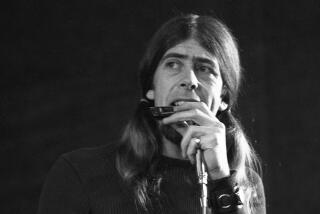Investing in the Future
Bruce Lundvall, the president of Blue Note and Metro Blue Records, has been a jazz fan since he first started collecting Lionel Hampton discs when he was 10 years old.
“If I weren’t doing what I’m doing,” he says, “I’d be a failed saxophone player.”
But it took Lundvall, 62, a while to get to the point where he could completely focus on the music he loves best. In his 21 years at Columbia Records, where he served as president of the domestic division from 1976 until he moved to Elektra in 1982, Lundvall administered a wide array of pop acts, as well as a jazz roster that included Wynton Marsalis, Stan Getz, McCoy Tyner, Dexter Gordon and others.
In 1985, he was asked to take over a revival of the legendary Blue Note jazz label. The home, in the ‘50s and ‘60s, to such important artists as Thelonious Monk, Miles Davis, Sonny Rollins, the Jazz Messengers, Horace Silver and others, the company had been floundering since the ‘70s, passing through ownership by Liberty and EMI Records before winding up with EMI’s Manhattan label, then presided over by Lundvall. In the decade since its return to production, Blue Note, under Lundvall’s stewardship, has once again become one of the world’s primary jazz companies, with acts ranging from singer Cassandra Wilson and pianist Jacky Terrasson to tenor saxophonist Joe Lovano and guitarists John Scofield and Charlie Hunter in its diverse roster.
In 1998, the company makes a significant move in the direction of what Lundvall sees as a increasingly important creative arena--Latin jazz--with the first releases from its recent signing of such world-class Cuban acts as pianist-bandleader Jesus “Chucho” Valdes and the band Irakere.
Lundvall’s extensive music business experience, as well as his role at the head of Blue Note, positions him as one of the jazz world’s most influential voices. A conversation about his thoughts on the coming year in jazz ranged from a broad perspective of the business in general to his more specific plans for a year in which Blue Note will celebrate its 60th anniversary.
*
Question: What kind of year do you anticipate for jazz in 1998?
*
Answer: Well, let’s start with the good news. I think it’s important that VH1 is talking about a jazz channel. That’s good news, even if it turns out to be soft jazz. And I think there’s growing media awareness of jazz. There is more opportunity on television, even on network shows, for jazz artists, and that’s good news too.
Also, I like the fact that the audiences seem to be getting younger. And I applaud what’s happening in the stylistic arena of artists such as Charlie Hunter and Medeski Martin & Wood--and that’s not just because they’re on my label. I really think there’s a growing audience for the kind of music they’re playing.
Players like that represent another upbeat sign, which is that more and more new jazz artists are emerging onto the scene. That’s been happening since Wynton arrived as a kind of jazz Pied Piper in the ‘80s. But now we’re seeing a kind of third generation that’s showing up--young players like tenor saxophonist Mark Shim and vibist Stefan Harris, both of whom will have new Blue Note albums in ’98.
Q: And the bad news?
A: Well, the marketplace was very soft in 1997. And when this happens to the entire record business, the people that get hurt badly are the classical people, the jazz people and the niche areas of the business. You can’t ship as many records out, and that’s not good news. But this is reflection of the record business in general, not just jazz.
Q.: But you anticipate a turnaround in the coming year?
A: I’m a positive person, and I believe that there will be. I’m going into ’98 with a positive attitude, even though ’97 had some real dry spells. But, for me, it always comes down to the artist, and to the music itself.
I firmly believe that what’s happened is that, in the pop world, it’s been instant gratification for audiences, who then turn around and go right on to the next act. There’s just not much artist loyalty, and that’s affected the entire record business. But I think it’s interesting that this kind of burnout process seems to be moving more younger people toward jazz. I have a 25-year-old guy, for example, who is my personal trainer. I started taking records to him, and now he’s become converted to a die-hard jazz fan.
Q: Do you see this attraction to jazz on the part of younger listeners having an effect upon sales?
A: I think so, although it’s hard to track. But there is one kind of odd problem that crops up. As you know, once you get wrapped up in jazz, it can become like an addiction. And as youngsters start listening, they feel they have to fill in their collections--with Sonny Rollins, John Coltrane, Charlie Parker and so forth. So they’re probably not going to buy the younger acts, like, say, the Greg Osbys, right away because they feel that they have to get hip and hear all the sources. Because there’s no aging in jazz. Young jazz fans talk about Coltrane and Charlie Parker as though they’re still here.
Q: Which raises the question of catalog and reissues, which seem to be appearing with great frequency.
A: Yes, but no more than in the past. Catalog at any jazz label is probably 50% of the business [Editor’s note: That is, of overall sales, domestically and internationally]. It was probably less before the advent of CDs, when everybody started putting out catalog. But there’s an important difference between jazz and pop catalog. For the most part, if you sign the right jazz artist today, you can be putting out reissues in a decade or so. I’m actually reissuing records that I made, as LPs, when we restarted Blue Note in 1985--with Jimmy Smith, James Newton, people like that.
Q: You mentioned the arrival of many new young jazz artists. Given the “soft” aspects of the business, what will it take in ’98 for entry-level performers to break out?
A: Good press, first of all. It’s extremely important, because of the low airplay availability for jazz. But touring is very, very important, too, and touring in the clubs as a leader, not a sideman.
Q: That sounds good, but how does a young, relatively unknown act manage to finance tours?
A: It’s a dilemma, true. Jazz labels have budgets for that kind of support, but it’s not a lot of money. My own view is that jazz acts should go out on tour in a van, like pop acts. And I’d like to see some of the young, straight-ahead jazz players get themselves booked as opening acts into non-jazz venues--and do it for peanuts if they have to. I’d like to see jazz acts working in every kind of club imaginable--get out there and play in front of kids who can eventually become new jazz fans. I think it’s a smart, productive approach, and I’m looking for acts willing to tour that way. I’d also like to see more good original material, with good melodies coming from the younger players. I don’t think we’re seeing the quality of jazz compositions now that we saw in the past, although I think Jacky Terrasson has the potential to produce some fine work.
Q: And, since Terrasson is a French artist, that brings up the issue of the international market for jazz. Does it continue to expand?
A: Absolutely. It’s now about the same size as the U.S.--that means 50% of our sales [of both new releases and reissues]. The Japanese market, in particular, is huge, the second-biggest jazz market in the world. We release all our product there--Blue Note, Pacific Jazz, everything. But we’re also beginning to get penetration into countries you wouldn’t ordinarily think of as jazz markets--Italy, Spain and Portugal, for example. On our label, pianist Renee Rosnes is big in Canada, in part of course, because it’s her home. But Ray Barreto is huge in France, of all places, and Ron Carter does very well in Japan.
Q: How important do you see Blue Note’s decision to make Latin jazz a part of your future planning?
A: Very important. I’ve been strong on Cuban jazz, in particular, since I put together the Havana Jam in 1979, which was the first set of concerts in Cuba by American artists in more than 20 years. That’s why we signed Chucho Valdes and Irakere, who will have new albums in 1998 with us.
And our company in Spain has made a deal for the Caribe label--a licensing deal--which allows us to put out their releases, selectively, here. We’ll be releasing albums by a band called Los Van Van, as well a fine young group called NG La Banda [New Generation--The Band], all on our Metro Blue label.
Q: Blue Note has become a far more diversified label under your direction than it was in its original incarnation. Do you see your approach--which includes mainstream, smooth jazz, some world music acts, singers, etc.--as a kind of template for a successful jazz label?
A: Well, I certainly hope so. I’d like to be doing this until I collapse. And Verve, our principle competitor, takes a similar approach. I’ll say this: We’ve always been profitable to the corporation, generating around 18% to 20% profit on sales. And even though ’97 was a soft year, we still should be around 12% to 13%.
The bottom line for me, in trying to be a label for our time, is to try as much as possible to keep on top of what’s going on in the music world, in the broadest sense. That means being involved in all areas of the business--as you say, maintaining a full-range roster, with soft jazz and other styles. What it really comes down to, however, is that most basic jazz requirement--that you try to sign and support the careers of adventurous artists, regardless of their style.
(BEGIN TEXT OF INFOBOX / INFOGRAPHIC)
CROSSROADS
The daily Calendar section is presenting a series of interviews, which began Monday, Dec. 29, and will conclude Thursday, Jan. 8, with arts and entertainment leaders. Here is the schedule:
Monday
Film: Harvey Weinstein
Tuesday
Architecture: Zaha Hadid
Wednesday
Television: Martha Williamson
Thursday
Restaurants: Nancy Silverton
Friday
Theater: Peter Schneider
Today
Jazz: Bruce Lundvall
Monday
Music: Tan Dun
Tuesday
Art: Paul Schimmel
Wednesday
Pop music: Danny Goldberg
Thursday
Dance: Arthur Mitchell
More to Read
The biggest entertainment stories
Get our big stories about Hollywood, film, television, music, arts, culture and more right in your inbox as soon as they publish.
You may occasionally receive promotional content from the Los Angeles Times.










